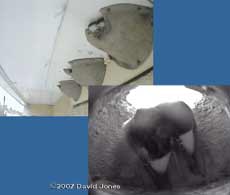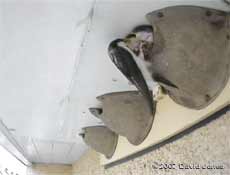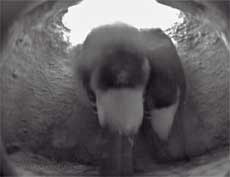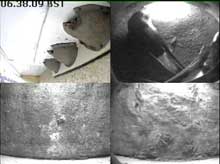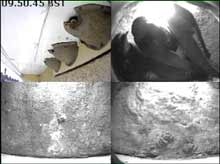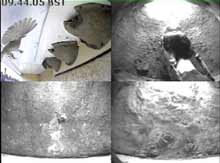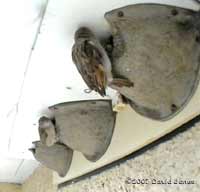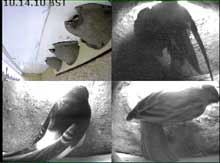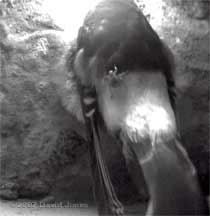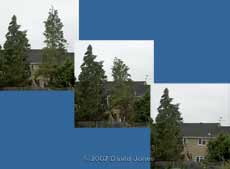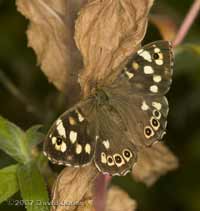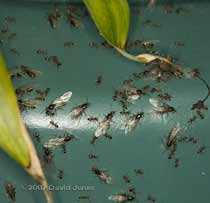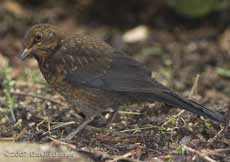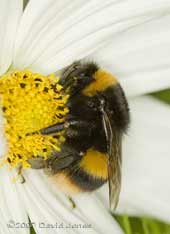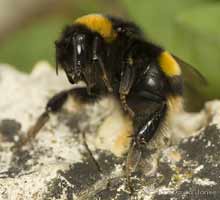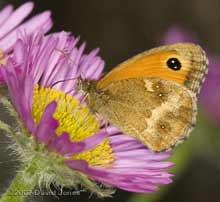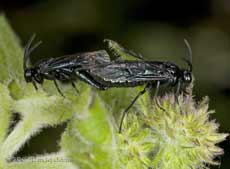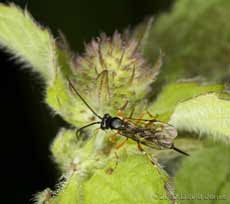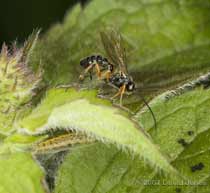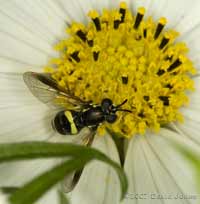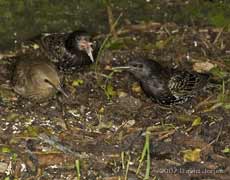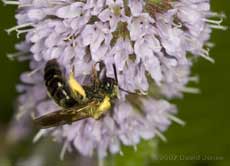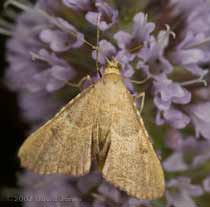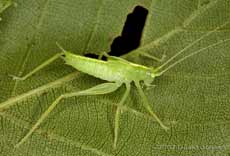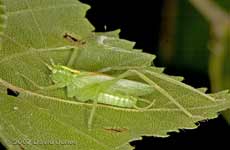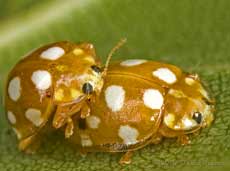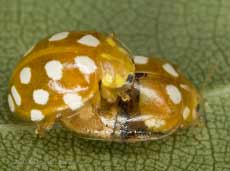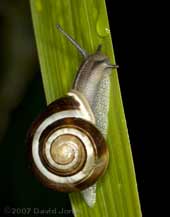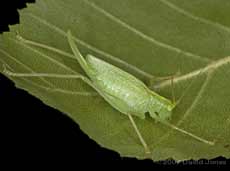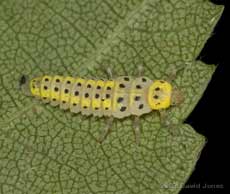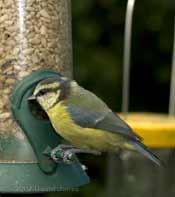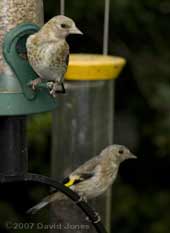Go to the last entry on this page ... .....Go to previous entry10 July - A largely grey, but dry day with the temperature struggling to reach 17C this afternoon
To be truthful, these are not Martins that have grown up here, but rather a family that seems to have taken a fancy to the nestboxes as a resting place for their fledglings. Since they first arrived some time after 10am there has been at least one in box 1 - most of the time there are two of them although there were three for a few minutes earlier on.
And they are being fed here by both of their parents.
Look at the back of the left-hand bird in this image and you will see that it is already learning to live with unwelcome passengers, as one of their larger parasites scurries across its back. Not surprisingly, the fledging spends a lot of time dealing with itches!
While I wouldn't expect these youngsters to stay very long, at least I can be sure that the adults are familiar with the nests and that makes me optimistic about the possibility of a late brood - my fingers are well and truly crossed. With that possibility on the cards I will be reinstating the webcam this afternoon, and I will restart the nestbox diaries if nesting does get going. This evening, sometime soon after 8.40pm, an adult joined the two fledglings and it looks at though they have settled down for the night. Finally, a mention of the Swifts. I can confirm that they are definitely nesting in my neighbours' loft, despite all their problems with the Starlings. While I was outside looking at the Martins, two Swifts emerged from the roof space, both swooping low past me, and I have seen them return a couple of times during the day. That may indicate that they have young to feed?
On a couple of occasions I've seen three in nest 1, and once there were four in there.
The Martin activity seems to have attracted the attention of the local House Sparrows. The Sparrows had not shown any interest in these nests during the Spring, but for a short time this morning that changed.
They checked out all three nests - there was a Martin in nest 1 when this Sparrow looked in,
and even entered nests 2 and 3 a couple of times. This webcam image shows a Sparrow in nest 2 while the other nests were occupied by Martins! Since that half-hour period this morning I haven't seen the Sparrows return, and their attention doesn't seem to have put the Martins off.
I've been encouraged by the number of visits I've seen the adults making when there have been no fledglings about, and in this image of nest 1 at least one of the feathers was brought into the nest, rather than being discarded during preening.
This evening there are two birds in nest 1 and one in nest 2 at 8pm, so it looks as though they will be roosting here again tonight. The individual is having to put up with a large parasite ( a better picture this time) which moves over its body extremely quickly every time the bird reacts to the irritation it causes. The parasite is probably Oeciacus hirundinis, the Martin Bug (an ectoparasite that feeds on the Martin's blood, but can also drink human blood, so cleaning out the nests needs special care!)
I have decided to wait a bit longer before restarting the nestbox diary, but if I do all the notes on this page will be copied across to it. Back down at garden level, the carder bee nest has suffered a small amount of damage overnight. Some Red Campion stems have been trampled down in front of the entrance and there are lumps of moss that have been torn away from the mound. However, it looks as though the bees have been busy doing repairs and there were no gaps in the cover when I noticed the damage at 11.30am.
12 July - A dull, damp morning with the temperature struggling to reach above 18C at lunchtime, although as I write this at 1.45pm there is sunshine! With the continuing activity at the House Martins nests, I have now restarted the nestbox diary so you will need to go to there to find out the latest (and promising) news. The entries for the last two days have been duplicated in that diary for the sake of continuity. Ever since we have lived here, a line of conifers, planted as a visual barrier between the houses in our road and what used to be a brick works, has acted as an animal corridor, linking us with the Brickfields Park. Since houses replaced the commercial site, this line of trees has been eroded away. with some trees removed completely and others having been reduced in height.
By the time I got upstairs to our bedroom the middle tree of this group had already gone, and I was just in time to see the blackbird's perch toppling. A short while later and the tree on the left had gone too!
These trees are not immediately adjacent to our garden but it is still sad to see them disappear completely. Over the years, numerous birds have nested in them, most notably the Goldcrests, a bird that we just do not see in the garden any longer - such is progress. Those who have followed my diaries over the years will know that we once had Leylandii at the bottom of the garden and that we cut down when they became too big and difficult for me to control. I like to think that since then we have made every effort to replace them with the trees and shrubs we have added to the garden. Lets hope this new tree clearance isn't just to get a neat lawn, and that something will be planted to replace the conifers.
The only pictures taken in the garden today were of this Speckled Wood butterfly that landed on a Great Willowherb stem to sunbathe, allowing me to get close to it this time. There were also a couple of Holly Blues about, but I could not get anywhere near near to them.
17 July - The last few days have seen sunshine and showers replacing largely grey skies, although temperatures have dropped a degree each day so that today it only just made it to 20C. Today has been rather breezy, with wind gust up to 30mph. Over the last three days, a variety of other activities have meant that few pictures have been taken.
On Sunday (15th), some of my family were here for the afternoon, and the weather was good enough to eat outside. During the meal, one of my sons drew my attention to the bottom of the garden where large numbers of insects were flying up form behind the water butt. A quick walk down the path, and we found ourselves brushing off scores of flying ants. There were hundreds of them climbing up the compost bin as well as the water butt.
Within half an hour the whole event was over, and across the garden it seemed that every plant seemed to have a queen ant perched on it, and every cobweb had several entangled in its threads. There were only small numbers of winged males. Before 4pm my sons were fascinated by the appearance of 'our' hedgehog as she first of all headed up the slope to the West Wing and then made her back down along the side of the garden, round the back of the ponds, past the Hawthorn and into our neighbour's garden through the opening next to our veranda. I must ask my neighbour if he would mind me nipping into his garden to see where it goes next.
Over the last two days this young Blackbird has been appearing under the Hawthorn in search of food. I think it's the first juvenile I've seen here this year.
Also yesterday, I came across this queen Buff-tailed Bumblebee (Bombus terrestris). At some 25mm long, its the biggest queen that I have seen here since the Spring and I am rather surprised to see one in mid-July. When I first spotted it, it was wandering somewhat haphazardly across the concrete surface of our driveway.
It was very agitated when I first approached, raising itself up into this defensive posture. As it was heading for the road I used a plastic ruler to pick it up and take it into the garden. As I walked back into the garden it walked along the ruler and onto my hand. All was well until I moved my hand so that it could walk onto a flower. As it left, I must have moved too rapidly, and I felt the wrong end of its sting stab my skin momentarily!
Today I have a rather puffy left hand with an annoying itch to remind me to take more care! It's the first time I've ever been stung by either a bee or a wasp.
This morning we had another butterfly in the garden, this time a Gatekeeper (Pyronia tithonus), keeping low amongst the vegetation and feeding on this Osteospermum. That was one of the plants we bought to try and tempt the solitary bees, and which was almost completely ignored by them. At least the Gatekeeper appreciated them.
19 July - The nearest to a summer's day for a couple of months, with the temperature getting up to almost 23C this afternoon! Dealing with the technical problems with our router, as well as a few other tasks kept me out of the garden for much of the time, but I did find a couple of things to record.
I was surprised to see these. I saw adults back in mid April but have seen neither adults or the larvae that feed on the Iris leaves since then. I wonder if this is a second emergence, or adults whose emergence was delayed because of the cooler temperatures that have prevailed this last couple of months.
I need to take another look at the original image to provide a scale for this photograph, although I guess its body must have been around 10mm in length (body without ovipositor).
As it moved from leaf to leaf it was continually probing with its ovipositor. Most ichneumons use caterpillars as hosts for their larvae - I wonder if the fly had sensed the presence of the caterpillar under the leaf in this photograph.
I've been ignoring the hoverflies recently, but at lunchtime I spotted this species which is unusual in the garden. I can't identify it using my 'Hoverflies of Surrey' book, but I suspect that it is a Dasysyrphus species. Perhaps I'll spend some time searching the web for clues tomorrow.
While there seems to be a lack of ladybirds activity around the garden at the moment (beyond the small number of Orange Ladybirds in the Birch), the Harlequin Ladybird came up as a topic of discussion in the BBC Radio 4 programme 'The Material World' this afternoon. The presenter Quentin Cooper was talking to Mike Majerus of Cambridge University (he identified the unusual 2-spot Ladybird for me back in May) and one of his students about the spread of the Harlequins. You can hear the programme by going to the Material World website and using the 'listen again' facility - it's worth listening to, and if you want to skip the first part of the programme, the Harlequin discussion starts about half way through.
25 July - Since that last entry the signs of summer have receded once more, and today the temperature on just struggled above 17C under solid grey skies, and with light rain/drizzle falling from lunchtime onwards. The unsettled weather, along with a combination of other tasks and tiredness(!) have meant that there are only a few pictures to add. Over the last few days there have been times when we could get outside. In fact, yesterday was dry all day, and we were having a meal outside when 'our' hedgehog trotted past as it headed off to its usual path under the garden fence! I must try to get a picture that shows how high its body is raised as it moves. Up to now the trouble will getting that shot is that the hedgehog usually stops, then moves off slowly once it realised that we are about. That may change now, as the postman delivered a wireless remote this morning. Unlike the infra-red one that I already have, this one uses radio frequencies which is better for use out of doors, and it has a longer range, able to trigger the camera when I am at the opposite end of the garden.
I had hoped to catch one of the adult blackbirds who must have offspring in a nest nearby as they have been taking away mealworms by the beakful these last couple of days - the Starlings beat them to the meal while the camera was set up.
Insects like our small bees have to take advantage of every bright spell to get out to find food. Here, one visits one of the Mint plants that are now in flower around the big pond. The carder bees continue to come and go from their nest, although I have to wonder how they are managing inside it. The moss must be saturated.
On another mint inflorescence in the middle of the day was this (unidentified) micro-moth which spent ages feeding from just a couple of flowers.
This is one of two Oak Bush Crickets (Meconema thalassinum) seen on the Birch over the last few days. This is a late stage instar (nymph), with partially developed wings and the two structures (cerci) at the end of the abdomen suggest that it is a male.
The second one is an adult male, with fully developed wings.
As I mentioned in my previous entry, at the moment the only ladybirds that I'm finding in the garden are the Orange Ladybirds in the Birch. A couple of nights ago I could see six of them, with four involved in mating. This pair seemed to be reasonably healthy, with just a couple of blemishes when looked at carefully,
but the female in this picture clearly shows substantial damage to its right wing case which appears to be split. I hope this doesn't prevent her from producing offspring.
The very damp conditions have been very slug and snail friendly, and although I haven't been taking slug pictures (I should have done!) I must include this snail that was 'wandering over one of the bamboo plants. It would take a very large hedgehog to tackle some of the slugs that are roaming the garden at the moment!
31 July - Another gap, this time I blame the House Martins, and the fact that we have foolishly decided to redecorate our bedroom. Today, as we have had the best day for a long time, with sunshine from dawn until dusk, and a maximum temperature of 22C (although it felt warmer in the sunshine), I had a break from the work upstairs. While a lot of time was spent out in the garden, I'm afraid most of it was spent doing nothing (which I fin is actually quite difficult!). It did mean that Sheila was able to confirm a sighting that I have made several times over the last few months (but have been hesitant about until now) as a Tern flew over us, heading north-east. There was no doubt about the shape, but I can't be more definite about the species - other than the dark beak it appeared to be all white when looked at from underneath. On a smaller scale, a Red-tailed Bumblebee visited the Cosmos flowers. These are rare visitors to the garden, The Garden Bumble Bee seems to be the most frequent species visiting the flowers here at the moment. The Carder Bee nest is still active, but to a lesser extent than in past weeks. There were four butterfly species seen today - Large White, Speckled Wood, Gatekeeper and Holly Blue. Large images will be added tomorrow!
In the last entry I included a picture of a Male Oak Bush Cricket. Today I spotted this female on the Birch (no sign of the male), with its large curved ovipositor.
In that entry I also recorded the mating Orange Ladybirds. Today I could only find two adults (on different parts of the tree) but I did find one small clump of eggs. I also found one very small nymph and this much larger nymph (about 1cm in length) from a much earlier mating.
For a short time I set a camera near the bird feeders (which I must get cleaned tomorrow) and captured a couple of images of young visitors. Along with a juvenile Great Tit, the Blue Tits are back and forth to the feeders frequently throughout the day. They usually go to the table where I put chopped up peanuts, but this one decided to have a change and head for the sunflower kernels.
Goldfinch numbers have been creeping back up after dwindling during the winter, and we now have a family group of at least ten making themselves heard and feeding at the Sunflowers and the Thistle seed feeder - these are juveniles, their mottled camouflage colourings clashing with the bright yellow wing flashes at this stage.
Click on images to see larger versions |
|
